Hydrodynamics
1. Let’s review some basic properties of fluid flow.
Solution:
Steady flow is such a motion of a fluid (gas) in which each particle moves in the same direction and with the same velocity.
It holds:
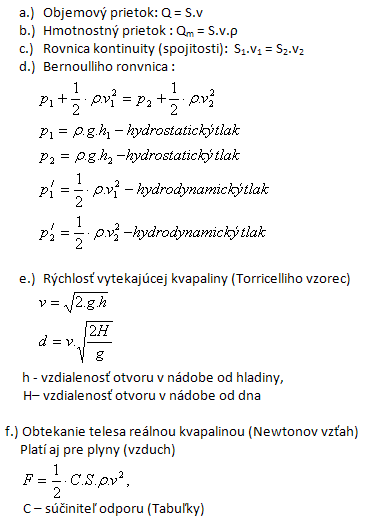
2.A pipeline with variable cross-section carries 5 liters of water per second. What is the velocity of flowing water at sections with areas
- a.) S1 = 20 cm2
- b.) S2 = 100 cm2
Solution:
Analysis:
Q = 5 l.s-1 = 5 dm3.s-1 = 0.005 m3.s-1, S1 = 20 cm2 = 0.002 m2, S2 = 0.01 m2
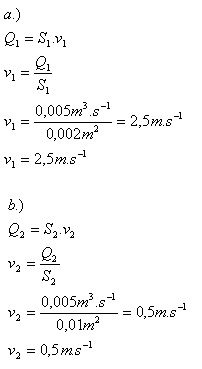
The velocities of flowing water are v1 = 2.5 m.s-1 and v2 = 0.5 m.s-1.
3.A small hydroelectric plant uses the energy of water flowing into a turbine from a height of 4 m. At what volumetric flow will the turbine have a power output of 600 kW if its efficiency is 75%?
Solution:
Analysis:
h = 4 m, P = 600·103 W, η = 0.75, ρ = 1000 kg.m-3, g = 10 m.s-2
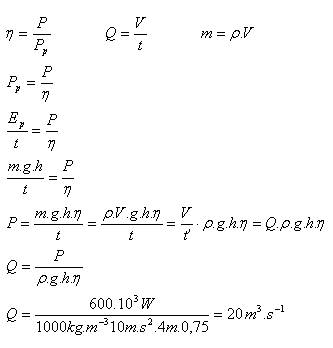
The turbine will have the required power at a volumetric flow Q = 20 m3.s-1
4.A pump delivers 300 l of water in 1 minute. The inlet pipe has a diameter of 80 mm, through the outlet pipe the water flows with a velocity of 8 m.s-1. Determine the velocity of water in the inlet pipe and the diameter of the outlet pipe.
Solution:
Analysis:
d1= 80 mm = 0.08 m, r1 = 0.04 m, v2 = 8 m.s-1
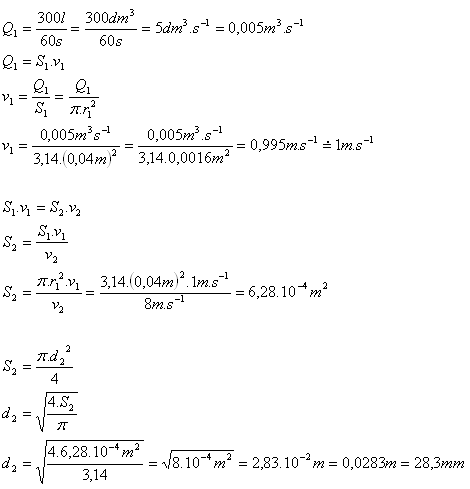
- The velocity of water in the inlet pipe is about v1 = 1 m.s-1.
- The diameter of the outlet pipe is d2 = 28.3 mm.
5.In the wider part of a tube, water flows with a velocity v1 = 10 cm.s-1. What is the velocity in its narrower part, which has half the radius?
Solution:
Analysis:
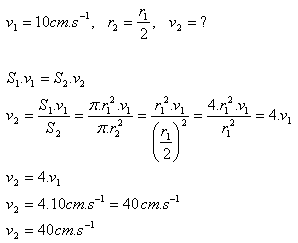
The water in the narrower part flows with velocity v2 = 40 cm.s-1
6.Diesel fuel (ρ = 830 kg.m-3) is transported through a pipe of diameter 40 cm at velocity 1.5 m.s-1. Determine
- a.) the hydrodynamic pressure in the pipe
- b.) the mass of diesel transported in 1 hour
Solution:
Analysis:
d = 40 cm = 0.4 m, r = 0.2 m, v = 1.5 m.s-1, t = 1 hr = 3600 s, ρ = 830 kg.m-3
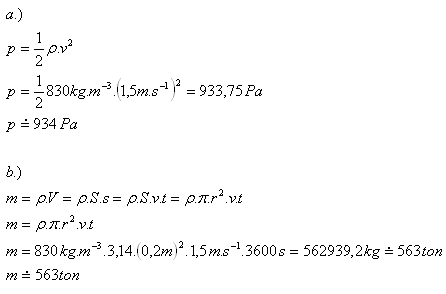
- The hydrodynamic pressure in the pipe is p = 934 Pa.
- The mass of diesel is m = 563 tons.
7.In a horizontal pipe with diameter d1 = 5 cm, water flows at velocity v1 = 2 m.s-1 and pressure p1 = 2·105 Pa. What is the pressure in the narrower part of the pipe with diameter d2 = 2 cm?
Solution:
Analysis:
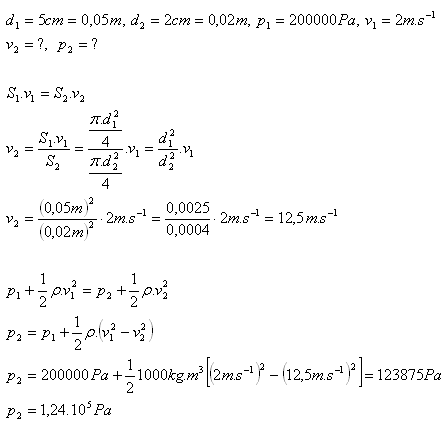
The pressure of the liquid in the narrower part is p2 = 1.24·105 Pa.
8.In a water pipe, water flows with velocity 2.24 m.s-1 and has a pressure of 0.1 MPa. What is the velocity in the constricted part where the pressure is 0.09 MPa?
Solution:
Analysis:
v1 = 2.24 m.s-1, p1 = 0.1 MPa = 0.1·106 Pa, p2 = 0.09 MPa = 0.09·106 Pa
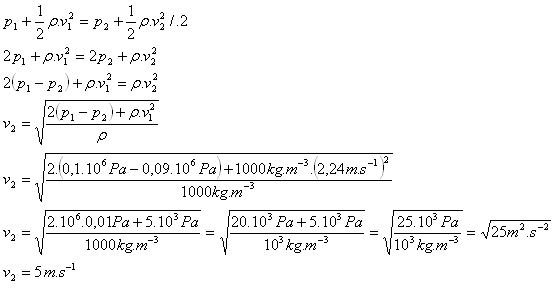
The velocity of water in the constricted part is v2 = 5 m.s-1
9.In the wall of a container filled with water, there is a hole 45 cm below the free surface. The container stands at the edge of a table so that the hole is 80 cm above the floor. At what distance from the table’s edge will the water jet hit the floor if the hole is opened?
Solution:
Analysis:
h = 45 cm = 0.45 m, H = 80 cm = 0.8 m
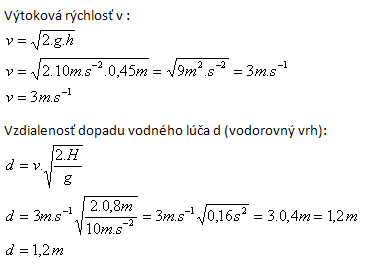
The distance of the water jet impact is d = 1.2 m.
10.A cylindrical container is filled with 18.84 liters of water per minute. At the same time, water flows out through a hole at the bottom with diameter 1 cm. At what height will the water level stabilize assuming ideal outflow of the liquid?
Solution:
Analysis:
d = 1 cm, r = 0.5 cm = 0.005 m
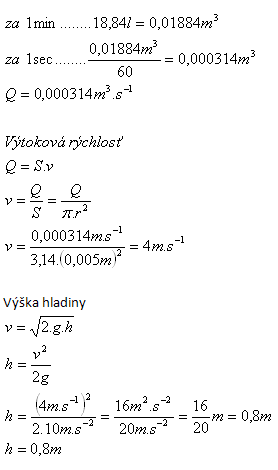
The water level will stabilize at height h = 0.8 m.
11. What drag hydrodynamic force acts on a sphere with radius r = 2.5 cm, if water flows around it with velocity 1.8 m.s-1. C = 0.48
Solution:
Analysis:
r = 2.5 cm = 0.025 m, v = 1.8 m.s-1, C = 0.48, ρ = 1000 kg.m-3
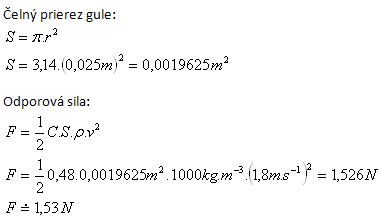
The drag force is about F = 1.53 N.
12. With what velocity does a raindrop fall if its mass is 0.005 g, radius 2.26 mm. ρ (air) = 1.3 kg.m-3, C = 0.4
Solution:
Analysis:
m = 0.005 g = 5·10-6 kg, r = 2.26 mm = 2.26·10-3 m, ρ (air) = 1.3 kg.m-3, C = 0.4
Frontal area: S = π·r2 = 3.14·(2.26·10-3 m)2 = 16·10-6 m2
Drag force: F = m·g = 5·10-6 kg·10 m.s-2 = 5·10-5 N
Falling velocity of the drop:
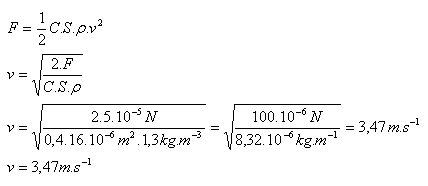
The raindrop falls with velocity v = 3.4 m.s-1
13.A submarine is subjected to a drag hydrodynamic force of 3600 N. The submarine has a frontal cross-section of 15 m2 and moves with velocity 14.4 km.h-1. Determine the drag coefficient C!
Solution:
Analysis:
F = 3600 N, S = 15 m2, v = 14.4 km.h-1 = 4 m.s-1, C = ?
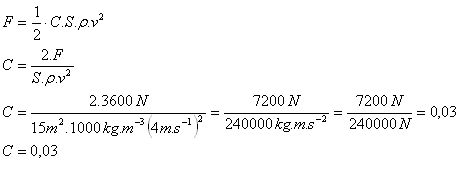
The drag coefficient of the submarine is C = 0.03
14.Calculate the terminal velocity of a parachutist with total mass 80 kg, if a hemispherical parachute has radius 5 m, drag coefficient 1.33, and air density 1.3 kg.m-3
Solution:
Analysis:
m = 80 kg, r = 5 m, C = 1.33, ρ = 1.3 kg.m-3, v = ?
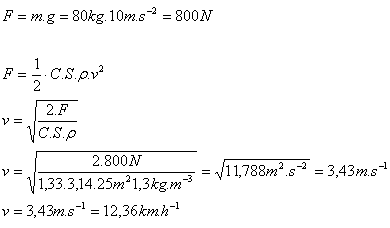
The parachutist’s fall stabilizes at velocity v = 12.36 km.h-1
15.
What is the radius of a glass bead (ρS = 2500 kg.m-3), if it falls in water (ρ = 1000 kg.m-3) with constant velocity v = 2 m.s-1. C = 0.48
Solution:
Analysis:
ρS = 2500 kg.m-3, ρ = 1000 kg.m-3, v = 2 m.s-1, C = 0.48
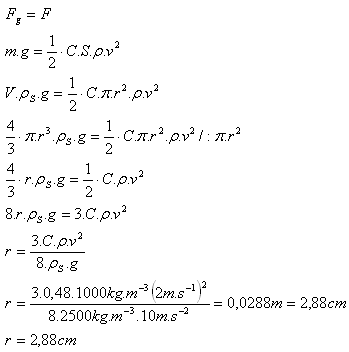
The glass bead has radius r = 2.88 cm.